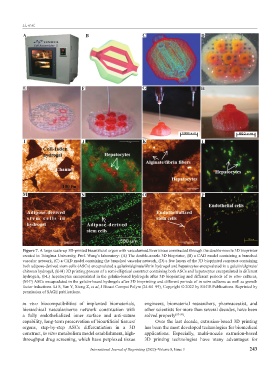Page 251 - IJB-8-3
P. 251
Li, et al.
A B C D
E F G H
I J K L
M N O P
Figure 7. A large scale-up 3D-printed bioartificial organ with vascularized liver tissue constructed through the double-nozzle 3D bioprinter
created in Tsinghua University, Prof. Wang’s laboratory: (A) The double-nozzle 3D bioprinter, (B) a CAD model containing a branched
vascular network, (C) a CAD model containing the branched vascular network, (D) a few layers of the 3D bioprinted construct containing
both adipose-derived stem cells (ASCs) encapsulated a gelatin/alginate/fibrin hydrogel and hepatocytes encapsulated in a gelatin/alginate/
chitosan hydrogel, (E-H) 3D printing process of a semi-elliptical construct containing both ASCs and hepatocytes encapsulated in different
hydrogels, (I-L) hepatocytes encapsulated in the gelatin-based hydrogels after 3D bioprinting and different periods of in vitro cultures,
(M-P) ASCs encapsulated in the gelatin-based hydrogels after 3D bioprinting and different periods of in vitro cultures as well as growth
factor inductions. Li S, Yan Y, Xiong Z, et al, J Bioact Compat Polym (24:84–99), Copyright © 2022 by SAGE Publications. Reprinted by
permission of SAGE publications.
in vivo biocompatibilities of implanted biomaterials, engineers, biomaterial researchers, pharmaceutist, and
hierarchical vascular/nerve network construction with other scientists for more than several decades, have been
a fully endothelialized inner surface and anti-suture solved properly [97-99] .
capability, long-term preservation of bioartificial tissues/ Over the last decade, extrusion-based 3D printing
organs, step-by-step ASCs differentiation in a 3D has been the most developed technologies for biomedical
construct, in vitro metabolism model establishment, high- applications. Especially, multi-nozzle extrusion-based
throughput drug screening, which have perplexed tissue 3D printing technologies have many advantages for
International Journal of Bioprinting (2022)–Volume 8, Issue 3 243

